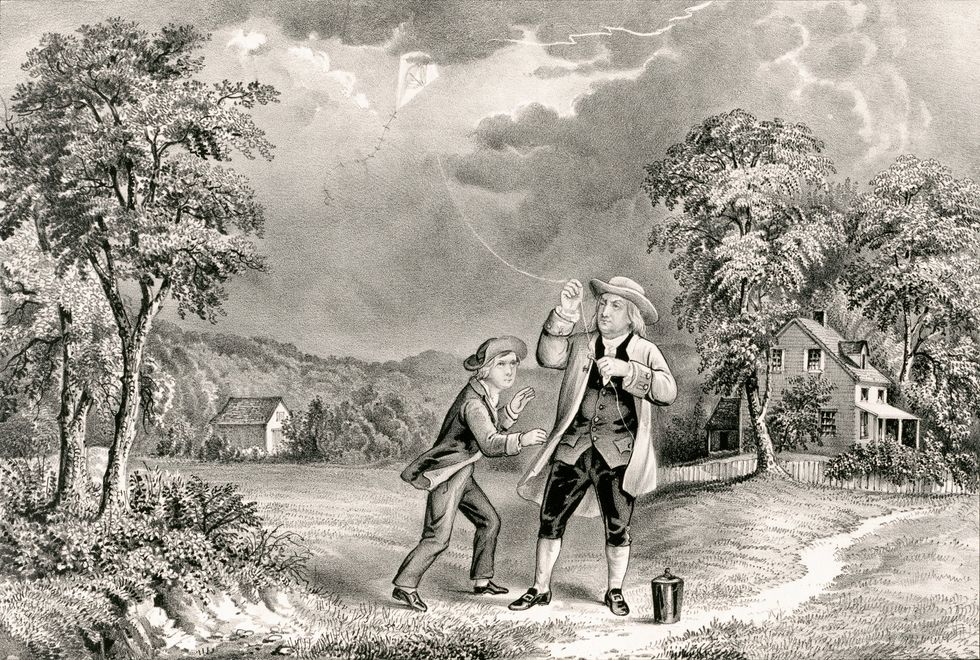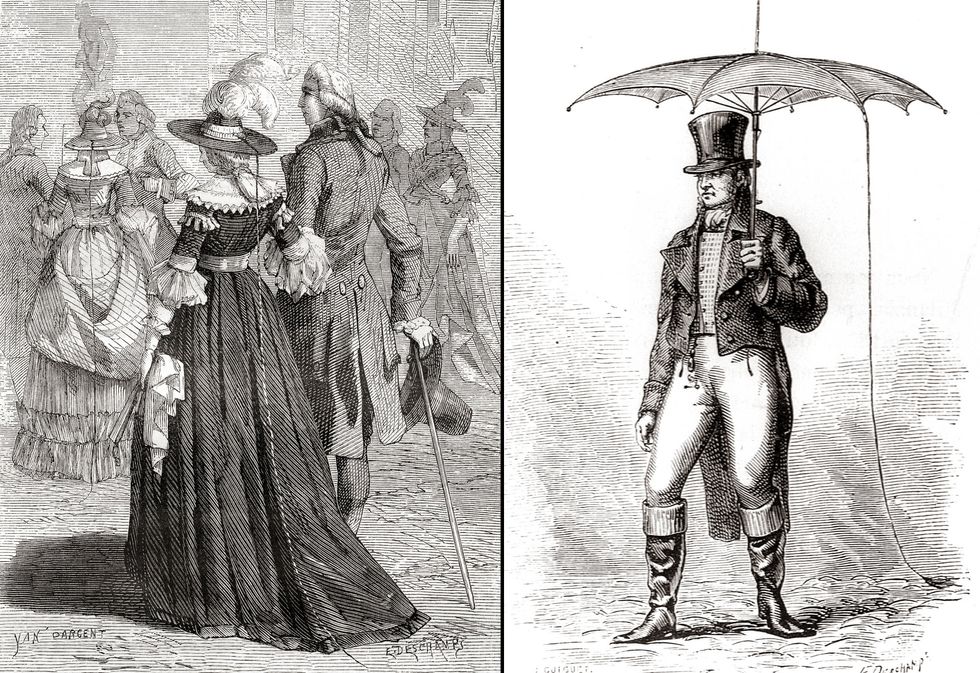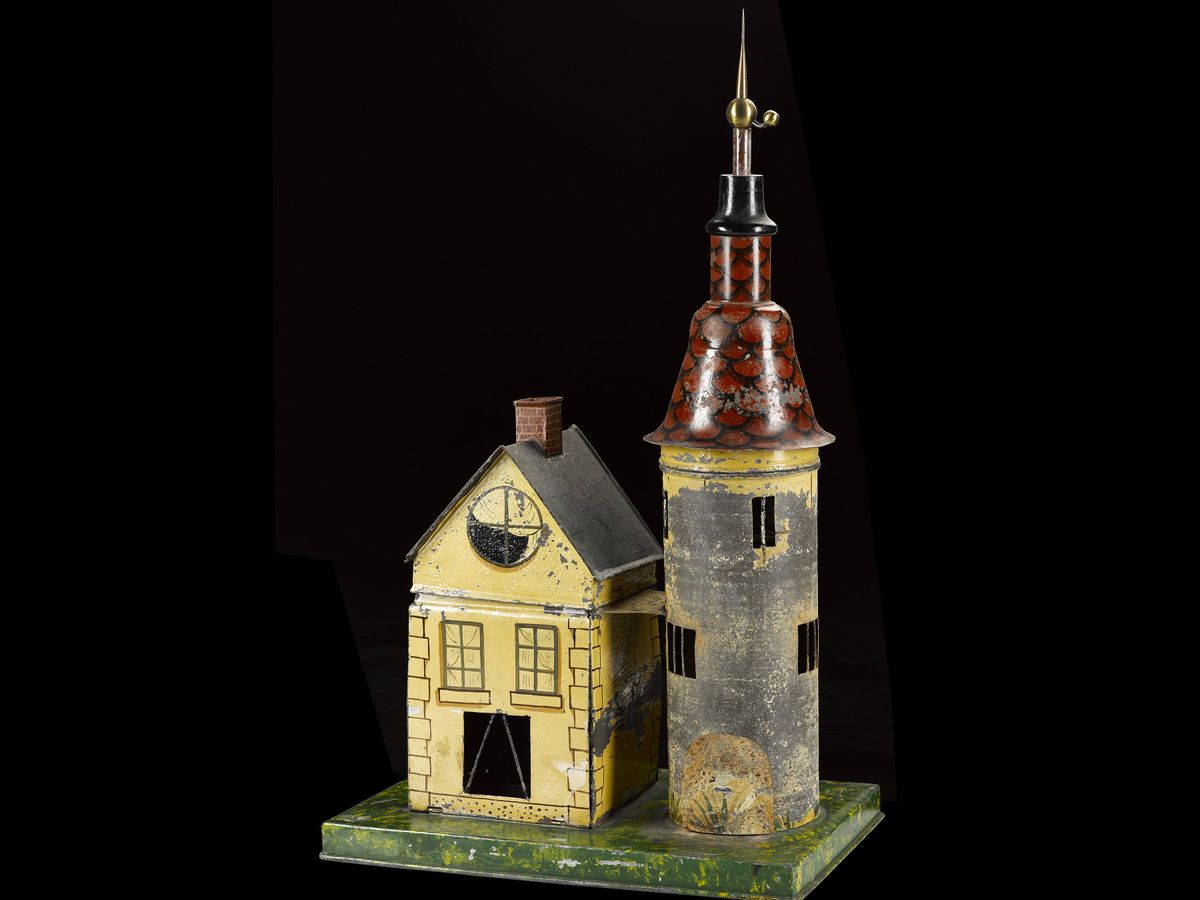Imagine if engineers were required to build a working model to demonstrate every new technological concept to the general public. Done right, tech literacy might soar! A compelling visual example can really help people understand the applications and implications of new technologies. That was the idea behind the thunder house, which in the second half of the 1700s became a popular means of getting out the word about Benjamin Franklin’s experiments on the lightning rod.
The thunder house was a simple tabletop device to show the benefits of a grounded versus ungrounded conductor. The demonstrator would place a small amount of gunpowder inside the model and then zap the house with an electric charge from an early battery called a Leyden jar. If the house had a lightning rod, simulated by a grounded conductor, the charge would pass through without incident. But if the house was set up with an open conductor, the charge would ignite the gunpowder and the sides of the house would collapse with a loud bang. This modern demonstration shows how it was done:
Thunder housewww.youtube.com
The demos were certainly dramatic, and yet it took years for lightning rods to catch on.
Ben Franklin’s experiments confirmed that lightning carries electricity
Franklin’s experiments with electricity began in 1745 when Peter Collinson, a Fellow of the Royal Society and patron of the American Philosophical Society, sent him a glass tube and a set of directions for experiments. Franklin enthusiastically undertook the research. By 1750 he had written back to Collinson proposing his own experiment to determine if the lightning he observed in the sky had the same electrical properties as that contained in a Leyden jar.
Thanks to a popular Currier and Ives print and some embellished mythmaking, most Americans assume Franklin made this breakthrough discovery with his famous kite experiment in 1752. But the engraving was made in 1876, more than 100 years after the fact, and it clearly took some liberties with the truth. For example, Franklin’s son William, who is pictured as an eager young boy assisting his father, was 21 years old at the time of the experiment. Also, the image shows the pair in an open field, but Franklin thought the experiment should take place on top of a tall tower or church spire; indeed, he delayed doing the experiment because there wasn’t an appropriately high building in Philadelphia at the time.

Of course, most myths have some basis in truth, and it is likely that Franklin did conduct the kite experiment with his son in June 1752. But the experiment Franklin proposed for determining if the clouds were electrified did not involve a kite at all.
On 29 July 1750, Franklin wrote to Collinson and suggested that a sentry box be placed on a tower or steeple. The box, big enough to hold a man and some electrical apparatus, was covered and kept dry, and a 6- to 9-meter iron rod passed upward through the box, ending in a sharp point. Franklin believed the rod could be used to indicate whether overhead thunderclouds were electrified. He published the sentry box experiment in his book, Experiments and Observations on Electricity, which was issued in London in 1751 and translated and published in France the following year.
Franklin’s suggested experiments met a tepid reception in England, but King Louis XV of France wanted to see them performed. Naturalist Thomas-François Dalibard set up a sentry box with a 12.2-meter pointed iron bar in the garden at his home at Marly-la-Ville, 25 kilometers north of Paris. On 10 May 1752, storm clouds gathered overhead. Dalibard was out of town, but he left instructions with his assistant, Coiffier, and the village priest, Father Raulet. Coiffier was thus the first to conduct Franklin’s experiment. When he brought a brass wire within a few centimeters of the iron bar, a spark jumped and emitted a sulfur smell, very similar to that from electrical experiments with Leyden jars. Raulet then successfully repeated the experiment six times over the course of 4 minutes, until the thunder and lightning dissipated and it started to hail.
Raulet sent an account of the experiment to Dalibard, who read it to the Académie Royale des Sciences in Paris on 13 May. Five days later, a colleague successfully replicated the experiment. Soon the experiment was being conducted across Europe. But the news was slow to reach North America, and Franklin conducted his kite experiment without knowing that the French had already proved his theory correct with the sentry box experiment.
The lightning rod’s adoption was not lightning fast
If science in real life proceeded as it does in the movies, Franklin’s verification that storm clouds are electrified would have swiftly led to the adoption of his suggested protection: the lightning rod. But reality rarely follows a tidy script, and historians have to pick through the evidence to figure out the actual order of events. I. Bernard Cohen published an essay on Franklin’s lightning rods in 1952 as part of the American Philosophical Society’s celebration of the bicentennial of the experiments. He later expanded this into his book Benjamin Franklin’s Science.
Franklin had proposed the usefulness of a lightning rod as early as 1750: “Would not these pointed Rods probably draw the Electrical Fire silently out of a Cloud before it came nigh enough to strike, and thereby secure us from that most sudden and terrible Mischief!” By 1751, Franklin’s friend and collaborator Ebenezer Kinnersley was using a thunder house to demonstrate the concept, giving lectures on the “Newly Discovered Electrical Fire” in New York, Boston, and Newport, R.I.

But more than a decade later, Franklin wrote to Kinnersley from England that he was disheartened by the lack of adoption: “Here [the lightning rod] is very little regarded; so little, that though it is now seven or eight years since it was made public, I have not heard of a single house as yet attempted to be secured by it.” Franklin was frustrated by people’s inertia when presented with what he perceived to be a clear solution to a problem. But he was fighting religious beliefs, personal grudges, and simple fear.
Long-standing Catholic and Protestant tradition (if not doctrine) called for the ringing of bells during thunderstorms to dissipate the diabolical nature of the tempest. As early as the 17th century, Cardinal Bellarmine (who crossed paths with Galileo) had reportedly denounced this practice, and Pope Benedict XIV advocated for the use of lightning rods soon after they were proven effective.
Unfortunately, some traditions die hard—and so did many bell ringers. Church steeples are of course favored spots for lightning strikes. Between 1753 and 1786, 103 church tower bell ringers died by lightning strike in France alone. I know if it were my job, I’d be begging for a lightning rod.
Petty disputes also got in the way of the lightning rod. For instance, Dalibard and Georges-Louis Leclerc had neglected to mention the work of Jean-Antoine Nollet, a French clergyman and leading electrical experimentalist, in their short introduction to Dalibard’s translation of Franklin’s work. In retaliation, Abbé Nollet attempted to suppress the news of the success of the sentry box experiment. When that failed, he engaged in fearmongering by capitalizing on the electrocution of Georg Wilhelm Richmann in 1753.
At the time of his death, Richmann had been attempting to replicate the sentry box experiment, but with the twist of hooking up an electrometer to measure the force of the atmospheric electricity. Unfortunately, he made the fundamental mistake of using an ungrounded rod, and on 6 August 1753 his became the first recorded death from electrical experimentation.
Franklin reprinted an account of the accident in the Pennsylvania Gazette and ended it with his own plug for the lightning rod: “And had his Apparatus been intended for the Security of his House, and the Wire (as in that Case it ought to be) continued without Interruption from the Roof to the Earth, it seems more than probable that the Lightning would have follow’d the Wire, and that neither the House nor any of the Family would have been hurt by that unfortunate Stroke.”
Eventually, lightning rods did become widely accepted, even if the science behind them remained a little murky for most people. Case in point: In 1778, French fashion designers proposed ladies’ hats and umbrellas with built-in lightning conductors. A metal chain trailed behind to dissipate the energy into the ground. Although such accessories were unlikely to attract a lightning strike, they also were unlikely to provide any protection. Perhaps if the fashion houses had seen a demonstration of a thunder house, they would have been less eager to design potentially fatal millinery.
Part of a continuing series looking at historical artifacts that embrace the boundless potential of technology.
An abridged version of this article appears in the April 2023 print issue as “Feel the Thunder.”
- This Cell Tower in the Swiss Alps Is Struck by Lightning More Than 100 Times a Year ›
- Ben Franklin’s Other Great Electrical Discovery: Turkey Tenderization ›
- Lasers Shot At Sky Can Guide Lightning ›
- Franklin’s Franklins Were Freakishly UnFakeable - IEEE Spectrum ›
- Why the British Navy Ignored a Life-Saving Lightning Rod - IEEE Spectrum ›
Allison Marsh is a professor in Women and Gender Studies at the University of South Carolina and codirector of the university’s Ann Johnson Institute for Science, Technology & Society. She combines her interests in engineering, history, and museum objects to write the Past Forward column, which tells the story of technology through historical artifacts. Marsh is currently working on a book on the history of women in electrical engineering.


